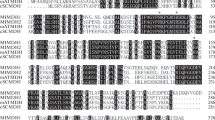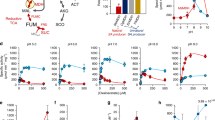Abstract
The aim of this study was to purify a malolactic enzyme (MLE) from Oenococcus oeni (O. oeni) strain and determine its properties in detail. O. oeni SD-2a was cultivated in the ATB broth supplemented with 7 g/L l-malic acid for harvesting the cells. After harvest, the cells were washed and disrupted for purification of MLE. MLE was purified from the supernatant of the disrupted cells through protamine sulfate precipitation, anion exchange chromatography and gel filtration chromatography. The purified MLE was identified using mass spectrometry. The MLE was purified by 43-fold with a yield of 0.42 % and possessed a specific activity of 419.2 U/mg. The purified enzyme with a nominal molecular mass of 59 kDa and a theoretical pI of 4.76 exhibited a maximum enzyme activity at 35 °C and pH 6.0, which retained over 50 % of its initial activity in the presence of 14 % (v/v) ethanol. Mn2+ was proven to be the most effective divalent cation to promote enzyme activity. Under the conditions of temperature 30 °C and pH 6.0, the K m and V max of MLE on l-malic acid were 12.5 × 10−3 M and 43.86 μmol/(min × mg), respectively. Moreover, the purified enzyme exhibited a higher stability with 0.1 M NaCl in addition and had a half-life of 30 days at 4 °C.







Similar content being viewed by others
References
Miller BJ, Franz CM, Cho GS, du Toit M (2011) Expression of the malolactic enzyme gene (mle) from Lactobacillus plantarum under winemaking conditions. Curr Microbiol 62:1682–1688
Bauer R, Dicks MT (2004) Control of malolactic fermentation in wine. A review. S Afr J Enol Vitic 25:74–88
Avedovech JR, Mcdaniel M, Waston B, Sandine W (1992) An evaluation of combinations of wine yeast and Leuconostoc oenos strains in malolactic fermentation of Chardonnay wine. Am J Enol Vitic 43:253–260
Liu S-Q (2002) A review: malolactic fermentation in wine: beyond deacidification. J Appl Microbiol 92:589–610
Lerm E, Engelbrecht L, du Toit M (2010) Malolactic fermentation: the ABC’s of MLF. S Afr J Enol Vitic 31:186
Lonvaud-Funel A (1995) Microbiology of the malolactic fermentation: molecular aspects. FEMS Microbiol Lett 126:209–214
Lonvaud-Funel A, Strasser De Saad AM (1982) Purification and properties of a malolactic enzyme from a strain of Leuconostoc mesenteroides isolated from grapes. Appl Environ Microbiol 43:357–361
Landete JM, Arena ME, Pardo I, de Manca Nadra MC, Ferrer S (2008) Comparative survey of putrescine production from agmatine deamination in different bacteria. Food Microbiol 25:882–887
Y-l Liu, Li H (2009) Integrated expression of the Oenococcus oeni mleA gene in Saccharomyces cerevisiae. Agric Sci China 8:821–827
Herrero M, Garcia LA, Diaz M (2003) Malolactic bioconversion using a Oenococcus oeni strain for cider production: effect of yeast extract supplementation. J Ind Microbiol Biotechnol 30:699–704
Knoll C, Fritsch S, Schnell S, Grossmann M, Krieger-Weber S, du Toit M, Rauhut D (2012) Impact of different malolactic fermentation inoculation scenarios on Riesling wine aroma. World J Microbiol Biotechnol 28:1143–1153
Rodriguez Nogales JM, Vila Crespo J, Fernandez Fernandez E (2013) Immobilization of Oenococcus oeni in lentikats (R) to develop malolactic fermentation in wines. Biotechnol Prog 29:60–65
Bartowsky EJ (2005) Oenococcus oeni and malolactic fermentation—moving into the molecular arena. Aust J Grape Wine R 11:174–187
Caspritz G, Radle F (1983) Malolactic enzyme of Lactobacillus plantarum. J Biol Chem 258:4907–4910
Spettoli P, Nuti MP, Zamorani A (1984) Properties of malolactic activity purified from Leuconostoc oenos ML34 by affinity chromatography. Appl Environ Microbiol 48:900–901
Vaillant H, Formisyn P (1996) Purification of the malolactic enzyme from a Leuconostoc oenos strain and use in a membrane reactor for achieving the malolactic fermentation of wine. Biotechnol Appl Biochem 24:217–223
Lemme A, Sztajer H, Wagner-Dobler I (2010) Characterization of mleR, a positive regulator of malolactic fermentation and part of the acid tolerance response in Streptococcus mutans. BMC Microbiol 10:1–12
Toit M, Engelbrecht L, Lerm E, Krieger-Weber S (2010) Lactobacillus: the next generation of malolactic fermentation starter cultures—an overview. Food Bioprocess Technol 4:876–906
Ansanay V, Dequin S, Blondin B, Barre P (1993) Cloning, sequence and expression of the gene encoding the malolactic enzyme from Lactococcus lactis. FEBS Lett 62:1274–1282
Labarre C, Guzzo J, Cavin J, Divies C (1996) Cloning and characterization of the genes encoding the malolactic enzyme and the malate permease of Leuconostoc oenos. Appl Environ Microbiol 62:1274–1282
Battermann G, Radler F (1991) A comparative study of malolactic enzyme and malic enzyme of different lactic acid bacteria. Can J Microbiol 37:211–217
Michlmayr H, Schumann C, da Silva NM, KulbeK D, del Hierro AM (2010) Isolation and basic characterization of a beta-glucosidase from a strain of Lactobacillus brevis isolated from a malolactic starter culture. J Appl Microbiol 108:550–559
Lonvaud-Funel A (1999) Lactic acid bacteria in the quality improvement and depreciation of wine. Antonie Van Leeuwenhoek 76:317–333
Arthurs CE, Lloyd D (1999) Kinetics, stereospecificity and expression of the malolactic enzyme. Appl Environ Microbiol 65:3360–3363
Gockowiak H, Henschke PA (2003) Interaction of pH, ethanol concentration and wine matrix on induction of malolactic fermentation with commercial “direct inoculation” starter cultures. Aust J Grape Wine R 9:200–209
Rojo Bezares B, Saenz Y, Navarro L, Zarazaga M, Ruiz-Larrea F, Torres C (2007) Coculture-inducible bacteriocin activity of Lactobacillus plantarum strain J23 isolated from grape must. Food Microbiol 24:482–491
Beltramo C, Desroche N, Tourdot-Marechal R, Grandvalet C, Guzzo J (2006) Real-time PCR for characterizing the stress response of Oenococcus oeni in a wine-like medium. Res Microbiol 157:267–274
Krieger SA, Hammes WP, Henick Kling T (1992) Effect of medium composition on growth rate, growth yield and malolactic activity of Leuconostoc oenos LoZH1-t7-1. Food Microbiol 9:1–11
Acknowledgments
This work was financially supported by the National Production of Grape Industry (CRAS-30-gi-3).
Conflict of interest
None.
Compliance with Ethics Requirements
This article does not contain any studies with human or animal subjects.
Author information
Authors and Affiliations
Corresponding author
Rights and permissions
About this article
Cite this article
Wang, P., Li, A., Dong, M. et al. Induction, purification and characterization of malolactic enzyme from Oenococcus oeni SD-2a. Eur Food Res Technol 239, 827–835 (2014). https://doi.org/10.1007/s00217-014-2276-y
Received:
Revised:
Accepted:
Published:
Issue Date:
DOI: https://doi.org/10.1007/s00217-014-2276-y




